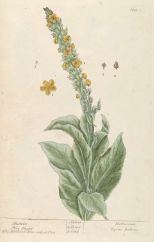Mullin' on Mullein
By Audrey Stallsmith

I am too near, too clear a thing for you,
A flower of mullein in a crack of wall,
The villagers half see, or not at all;
Part of the weather, like the wind or dew.
Lizette Woodworth Reese--"A Flower of Mullein"
As the above poem implies, mullein is one of those wildflowers so familiar that we tend to overlook it. And that isn't so easy to do with a biennial that has gray furry leaves and a four to six foot stalk of yellow blooms!
That stalk earned mullein the nicknames Aaron's rod, torches, and Jacob's staff, while the fuzzy leaves won it the monikers velvet dock, bunny's ears, beggar's blanket, and flannel flower.
It's official title is Verbascum thapsus, verbascum perhaps being a corruption of the Latin barbascum ("with whiskers.") Thapsus may refer to the North African town, in present-day Tunisia, where Julius Caesar won one of his most brutal victories. Apparently nobody knows for sure where the name "mullein" came from, though some speculate it could have derived from the Latin mollis for "soft."
As you can probably guess by now, mullein's not actually native to North America. It originated in the Mediterranean region, which suited its preference for arid soils. It probably came west with the Crusaders, then crossed the Atlantic with early settlers. In those days travellers took along medicinal herbs the same way that we pack prescriptions in our carry-on luggage.
And mullein was considered one of the most valuable, as it clears congestion, soothes mucous membranes, and reduces inflammation--making it a natural as the pre-Robittusin cough remedy! It's also recommended for those who suffer from other respiratory disorders, like asthma and emphysema.
If you are going to make a tea from the leaves, however, be sure that you strain that brew through a couple layers of muslin or similar fabric to remove all the little hairs. Perhaps those hairs are why some asthmatics chose to smoke mullein instead. But smoking to relieve a lung ailment doesn't strike me as a particularly bright thing to do!
Although you don't want it in your tea, mullein's down makes excellent tinder when dry, which is why the ancients employed it to light fires and make lamp wicks. The Romans also dipped the herb's long stalks in suet or pitch when they needed torches.
Perhaps due to its reputation for shining light on things, mullein also served as a protector against evil and witchcraft. It is supposedly the "moly" Ulysses used to defend himself against the charms of Circe. (Though I have heard the snowdrop suggested as a possible "moly" also.)
Perhaps in retaliation, some other "sirens" have employed mullein to enhance their allure, tinting their hair blonde with a dye derived from the yellow flowers. When tossed in water, mullein seeds supposedly intoxicate fish, making them easier to catch. Maybe Circe should have tried that on Ulysses!
The poor "heated things up" in a different way by adding mullein leaves to their shoes as insulation or even sleeping beneath them. And they may not have been the only ones! In Louisa May Alcott's Little Men, Demi comments, "I know one thing about this mullein leaf: the fairies use them for blankets."
The herb can provide comfort in other ways too, as it's astringency is supposed to cure diarrhea. Though too large a dose can be laxative instead! James Duke has summed up mullein's attributes quite succinctly in the following poem:
“Mullein leaf is one herb that they use
As an innersole lining for shoes
From what people tell
It cures asthma as well;
And helps when the bowels are loose.”
There is actually a wild mullein that I like better than thapsus which I have seen growing in similar conditions. Slighter and more delicate with pinkish white flowers, it is--I suspect--a form of Verbascum blattaria or moth mullein. It convinces me that I should really try some of the ornamental mulleins in my flower garden.
But, in the meantime, I'll pay more attention to the wildflowers I pass by. And not consider them simply "part of the weather!"
Verbascum thapsus image is from Herbarium Blackwellianum by Elisabeth Blackwell, courtesy of the Missouri Botanical Garden.








